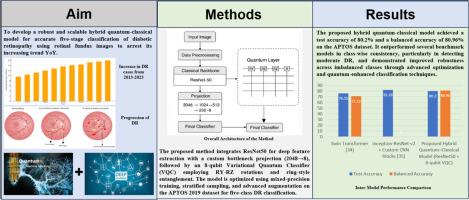基于混合量子经典深度学习框架的糖尿病视网膜病变平衡分类
IF 1.9
Q2 MULTIDISCIPLINARY SCIENCES
引用次数: 0
摘要
糖尿病视网膜病变(DR)是一种进行性眼病,是糖尿病患者可预防失明的主要原因。早期和准确的严重阶段分类对于有效治疗至关重要,但由于类别不平衡、高分辨率数据和现有模型的可扩展性有限,仍然具有挑战性。本研究提出了一种新的混合量子经典深度学习框架来解决五类DR分类中的这些限制。该模型在APTOS 2019数据集上实现了80.96%的平衡精度,优于所有DR阶段的几个经典基线。它针对计算效率和类别平衡学习进行了优化,使其适合部署在远程医疗平台和低资源临床环境中。这项工作提供了一种可扩展的基于人工智能的诊断方法,将深度学习与新兴的量子计算技术融合在一起。方法、结果和公开共享的代码库为从事人工智能医学成像和早期疾病筛查的研究人员和从业人员提供了一个可复制的框架。该方法适合低资源的临床环境和远程眼科应用。该方法包括:ResNet-50特征提取器,具有4级密集投影(2048→8),用于量子准备压缩;8量子位VQC,具有参数化RY-RZ门和环形纠缠,具有高表达性;分层采样+混合精度训练,用于效率和类平衡泛化本文章由计算机程序翻译,如有差异,请以英文原文为准。

Hybrid quantum-classical deep learning framework for balanced multiclass diabetic retinopathy classification
Diabetic Retinopathy (DR) is a progressive eye disease and a leading cause of preventable blindness among diabetic patients. Early and accurate classification of its severity stages is crucial for effective treatment but remains challenging due to class imbalance, high-resolution data, and limited scalability of existing models. This study presents a novel hybrid quantum-classical deep learning framework to address these limitations in five-class DR classification. The model achieves a balanced accuracy of 80.96 % on the APTOS 2019 dataset, outperforming several classical baselines across all DR stages. It is optimized for computational efficiency and class-balanced learning, making it suitable for deployment in telemedicine platforms and low-resource clinical settings. This work contributes a scalable AI-based diagnostic approach that fuses deep learning with emerging quantum computing techniques. The methodology, results, and publicly shared codebase provide a replicable framework for researchers and practitioners working in AI for medical imaging and early disease screening. This method is well-suited for low-resource clinical environments and tele-ophthalmology applications. The method involves an:
- •ResNet-50 feature extractor with a 4-stage dense projection (2048→8) for quantum-ready compression
- •8-qubit VQC with parameterized RY–RZ gates and ring-style entanglement for high expressiveness
- •Stratified sampling + mixed-precision training for efficiency and class-balanced generalization
求助全文
通过发布文献求助,成功后即可免费获取论文全文。
去求助
来源期刊

MethodsX
Health Professions-Medical Laboratory Technology
CiteScore
3.60
自引率
5.30%
发文量
314
审稿时长
7 weeks
期刊介绍:
 求助内容:
求助内容: 应助结果提醒方式:
应助结果提醒方式:


